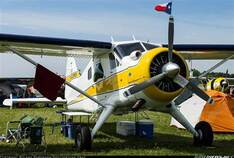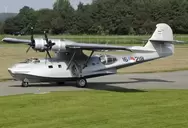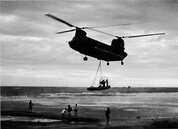Airplanes and Helicopters

Imagine an area the size of New York, dotted with many small villages, none of which were connected to each other by roads. Then imagine 83 fires in that same area, many threatening those wide-flung villages.
This was what we encountered as we worked throughout a six- week period from Kotzebue, Alaska. There, in a village second in size to the better-known Nome, and located 20 miles above the Arctic Circle, our BLM firefighting operations were set up in a little used wood house borrowed from the Federal Aviation Administration.
Moving about in this theater of operations required a massive air effort. Within a week of the call to action, we had leased more than 20 aircraft of various capabilities. We hired several Twin Otters, a WWII-era Catalina bomber, multiple small helicopters, an L-20 DeHavilland Beaver, an Aztec, a Merlin, several smaller Cessnas and even a loaned Chinook helicopter from Elmendorf in Anchorage. These were bolstered by the presence of an airfield at Kotzebue that accommodated commercial flights that could bring cargo and passengers into the town using aircraft as large as a Boeing 727 jet.
Each aircraft came with its own story!
The Catalina bomber was the most interesting. Flown up from California, it came with only one pilot. This gentleman looked old enough to have flown this plane in WWII! The plane itself, a retrofitted PBY, was designed to land on a body of water and skim the surface scooping water into a tank in its belly, The pilot would then release this load over a fire or hot-spot, helping to contain its spread.
We deployed the Catalina successfully on several hot spots, thus allowing us to avoid placing crews in those locations.
After the second week of occasional deployments, we received an alarming radio call from the pilot. One of his engines was on fire and trailing smoke. He was coming in from the west over Kotzebue Sound and could we, please, clear the airstrip so he could land!!
We immediately contacted our FAA colleagues and cleared all traffic. Then, frightened but engaged, our team lined up along the tarmac to observe the approach. Viewing was difficult due to the extreme smoke conditions, but we were able to watch as the Catalina emerged from the smoke fog a few hundred feet from the end of the runway. Right on target, the pilot aimed his crippled plane at the west end center of the runway, his left engine trailing a plume of coal/dark smoke.
The plane leveled and touched down smoothly with no hint that only the right engine was carrying the weight of the Catalina. The plane slowed and turned slowly down a taxiway leading to a large concrete “field” where we parked the aircraft used in our operations. With little effort the pilot guided his plane to a halt and parked.
The pilot, unflustered, asked to use our phone.
He called his home office in California and requested they send a new engine.
Within several days the engine arrived as regular freight. That pilot, himself, installed that engine and was operational within that week!
We had two other instances of damaged aircraft. Both involved our Twin Otters. These were STOLs- “Short Take-Off and Landing” aircraft which were the modern workhorses of the Bush. They were large enough to move a 15-person fire crew with its gear. They could land using a very short length of runway and, in fact, could land on rugged terrain where no runway existed.
One of our Otters carrying gear and provisions for a crew already deployed, landed on a sandbar on the Buckland River. The landing was not smooth, and one of the landing gear struts was damaged. The pilot, fearing a possible collapse if he tried a takeoff, called for help. With a fire nearby, we decided to immediate extract him using one of our smaller helicopters.
The pilot reported the damage and we prepared to send out a mechanic with parts to repair the strut and fly the plane back. But we were informed by the fire crew on the scene that the fire had shifted course and was running toward the plane!
For two days we waited, fearful that the fire would burn over and destroy our expensive piece of rented equipment!
Indeed, the fire DID burn over the Otter, jumped part of the river, and then died of its own accord.
With great trepidation, we flew over the burn, expecting to see a burned-out hulk of a plane.
Such was not the case! The plane was untouched, totally intact.
It was repaired and returned to service. We had lucked out.
Meanwhile, at another southern location nearer Granite Mountain, one of our helicopters was grounded after delivering supplies to a crew. It had developed a crack across one of its rotors, which, if flown, could cause a catastrophic failure. Somehow, we needed to replace the rotor on site so we could extract the injured bird! But how could we get such an unwieldly object to the location?
One answer, after reviewing our available resources, was to have one of our Twin Otters carry it to a sand bar only about a mile from the helicopter and then have some of the fire crew and a mechanic carry it in. The rotor blade, however, was too long to fit within the plane. So, we removed a door and slid the rotor into the plane as far as it would go. About 3 feet protruded from the door.
Our pilot assured us he could fly if the rotor blade was firmly secured to the fuselage and struts.
The operation was successful, and the helicopter repaired and retrieved!
We loved our Otters!
Another of our aircraft came from Elmendorf Air Force Base in Anchorage. It was a Chinook helicopter, rumored to once have been in service to a prior President of the U.S. While we never confirmed that rumor, the aircraft was indeed large and imposing. Loud too. You didn’t want to be standing close when it was in operation preparing to rise.
The Chinook came with a 3-man crew with the task of pre-positioning large 500-gallon rubber tanks of fuel for our smaller helicopters. It also came with the biggest beer cooler I’d ever seen. I know this because one late night I sat in the lounge of the NuLukVik Hotel, third floor, with this crew and a few other exhausted BLM employees. And Claire, a beautiful young woman who followed smoke-jumper Bob from Las Vegas to this adventure.
As we looked out, being early July, we watched the sun slide along the mountains across the Bay, never dipping below them. Night never came. But the Chinook helicopter crew chief did, with his crew’s beer cooler. The crew were all there due to a maneuver that grounded the operation of their “chopper”. After a week of long hours positioning the rubber “blivets”, also called “rollagons”, the crew had grown weary but were not given time to relax. The answer to finding time off was to somehow “lose” the gas cap to their aircraft. Since it would be at least a day’s time to get a replacement sent to Kotzebue, the crew was grounded.
So we sat and listened to the crew tell stories of what occurred as they worked. As the beer cooler was lightened, the stories became more animated.
We listened as they told of what happens when their 500-gallon “rollagons”, slung from a net below their Chinook, would start to swing. Imagine the outcome if the swinging was too wide. That is why they had a “kill” button that would release their load to bounce across the tundra as they pulled away. Somehow this image, fortified by multiple emptied beer cans, seemed hilarious.
When it was time for the crew to depart for bed, I too got up to leave. Claire, recently abandoned by her smokejumper who flew to Fairbanks for unexplained medical care, asked if I’d accompany her to her door down the hall. I did so. At the door, she asked if I’d like to come in and smoke a joint.
Alarm bells went off- I’d never smoked a joint. I was married. Claire was very attractive, and Claire would not be able to stay if she didn’t find different lodging arrangements. Even in my inebriated state, I knew enough to decline politely and high/tail it to my own room, alone.
The next day our Chinook crew received their gas cap and resumed their tasks.
And Claire returned to Las Vegas.
This was what we encountered as we worked throughout a six- week period from Kotzebue, Alaska. There, in a village second in size to the better-known Nome, and located 20 miles above the Arctic Circle, our BLM firefighting operations were set up in a little used wood house borrowed from the Federal Aviation Administration.
Moving about in this theater of operations required a massive air effort. Within a week of the call to action, we had leased more than 20 aircraft of various capabilities. We hired several Twin Otters, a WWII-era Catalina bomber, multiple small helicopters, an L-20 DeHavilland Beaver, an Aztec, a Merlin, several smaller Cessnas and even a loaned Chinook helicopter from Elmendorf in Anchorage. These were bolstered by the presence of an airfield at Kotzebue that accommodated commercial flights that could bring cargo and passengers into the town using aircraft as large as a Boeing 727 jet.
Each aircraft came with its own story!
The Catalina bomber was the most interesting. Flown up from California, it came with only one pilot. This gentleman looked old enough to have flown this plane in WWII! The plane itself, a retrofitted PBY, was designed to land on a body of water and skim the surface scooping water into a tank in its belly, The pilot would then release this load over a fire or hot-spot, helping to contain its spread.
We deployed the Catalina successfully on several hot spots, thus allowing us to avoid placing crews in those locations.
After the second week of occasional deployments, we received an alarming radio call from the pilot. One of his engines was on fire and trailing smoke. He was coming in from the west over Kotzebue Sound and could we, please, clear the airstrip so he could land!!
We immediately contacted our FAA colleagues and cleared all traffic. Then, frightened but engaged, our team lined up along the tarmac to observe the approach. Viewing was difficult due to the extreme smoke conditions, but we were able to watch as the Catalina emerged from the smoke fog a few hundred feet from the end of the runway. Right on target, the pilot aimed his crippled plane at the west end center of the runway, his left engine trailing a plume of coal/dark smoke.
The plane leveled and touched down smoothly with no hint that only the right engine was carrying the weight of the Catalina. The plane slowed and turned slowly down a taxiway leading to a large concrete “field” where we parked the aircraft used in our operations. With little effort the pilot guided his plane to a halt and parked.
The pilot, unflustered, asked to use our phone.
He called his home office in California and requested they send a new engine.
Within several days the engine arrived as regular freight. That pilot, himself, installed that engine and was operational within that week!
We had two other instances of damaged aircraft. Both involved our Twin Otters. These were STOLs- “Short Take-Off and Landing” aircraft which were the modern workhorses of the Bush. They were large enough to move a 15-person fire crew with its gear. They could land using a very short length of runway and, in fact, could land on rugged terrain where no runway existed.
One of our Otters carrying gear and provisions for a crew already deployed, landed on a sandbar on the Buckland River. The landing was not smooth, and one of the landing gear struts was damaged. The pilot, fearing a possible collapse if he tried a takeoff, called for help. With a fire nearby, we decided to immediate extract him using one of our smaller helicopters.
The pilot reported the damage and we prepared to send out a mechanic with parts to repair the strut and fly the plane back. But we were informed by the fire crew on the scene that the fire had shifted course and was running toward the plane!
For two days we waited, fearful that the fire would burn over and destroy our expensive piece of rented equipment!
Indeed, the fire DID burn over the Otter, jumped part of the river, and then died of its own accord.
With great trepidation, we flew over the burn, expecting to see a burned-out hulk of a plane.
Such was not the case! The plane was untouched, totally intact.
It was repaired and returned to service. We had lucked out.
Meanwhile, at another southern location nearer Granite Mountain, one of our helicopters was grounded after delivering supplies to a crew. It had developed a crack across one of its rotors, which, if flown, could cause a catastrophic failure. Somehow, we needed to replace the rotor on site so we could extract the injured bird! But how could we get such an unwieldly object to the location?
One answer, after reviewing our available resources, was to have one of our Twin Otters carry it to a sand bar only about a mile from the helicopter and then have some of the fire crew and a mechanic carry it in. The rotor blade, however, was too long to fit within the plane. So, we removed a door and slid the rotor into the plane as far as it would go. About 3 feet protruded from the door.
Our pilot assured us he could fly if the rotor blade was firmly secured to the fuselage and struts.
The operation was successful, and the helicopter repaired and retrieved!
We loved our Otters!
Another of our aircraft came from Elmendorf Air Force Base in Anchorage. It was a Chinook helicopter, rumored to once have been in service to a prior President of the U.S. While we never confirmed that rumor, the aircraft was indeed large and imposing. Loud too. You didn’t want to be standing close when it was in operation preparing to rise.
The Chinook came with a 3-man crew with the task of pre-positioning large 500-gallon rubber tanks of fuel for our smaller helicopters. It also came with the biggest beer cooler I’d ever seen. I know this because one late night I sat in the lounge of the NuLukVik Hotel, third floor, with this crew and a few other exhausted BLM employees. And Claire, a beautiful young woman who followed smoke-jumper Bob from Las Vegas to this adventure.
As we looked out, being early July, we watched the sun slide along the mountains across the Bay, never dipping below them. Night never came. But the Chinook helicopter crew chief did, with his crew’s beer cooler. The crew were all there due to a maneuver that grounded the operation of their “chopper”. After a week of long hours positioning the rubber “blivets”, also called “rollagons”, the crew had grown weary but were not given time to relax. The answer to finding time off was to somehow “lose” the gas cap to their aircraft. Since it would be at least a day’s time to get a replacement sent to Kotzebue, the crew was grounded.
So we sat and listened to the crew tell stories of what occurred as they worked. As the beer cooler was lightened, the stories became more animated.
We listened as they told of what happens when their 500-gallon “rollagons”, slung from a net below their Chinook, would start to swing. Imagine the outcome if the swinging was too wide. That is why they had a “kill” button that would release their load to bounce across the tundra as they pulled away. Somehow this image, fortified by multiple emptied beer cans, seemed hilarious.
When it was time for the crew to depart for bed, I too got up to leave. Claire, recently abandoned by her smokejumper who flew to Fairbanks for unexplained medical care, asked if I’d accompany her to her door down the hall. I did so. At the door, she asked if I’d like to come in and smoke a joint.
Alarm bells went off- I’d never smoked a joint. I was married. Claire was very attractive, and Claire would not be able to stay if she didn’t find different lodging arrangements. Even in my inebriated state, I knew enough to decline politely and high/tail it to my own room, alone.
The next day our Chinook crew received their gas cap and resumed their tasks.
And Claire returned to Las Vegas.


